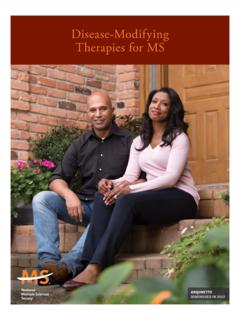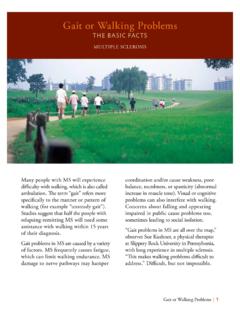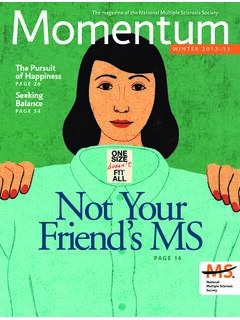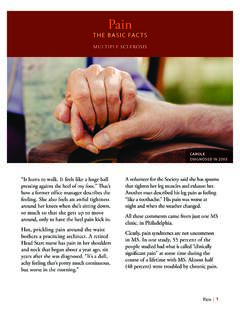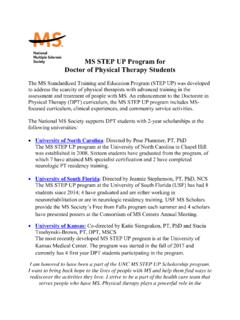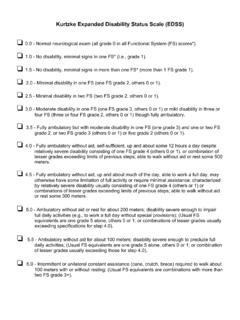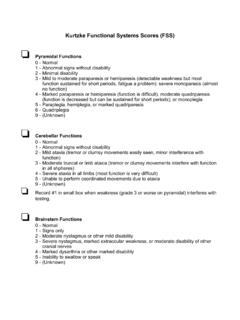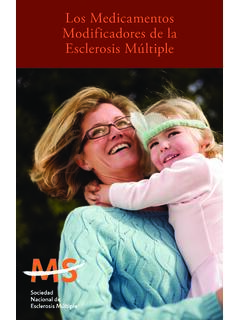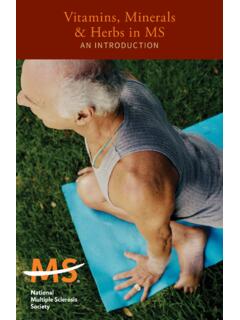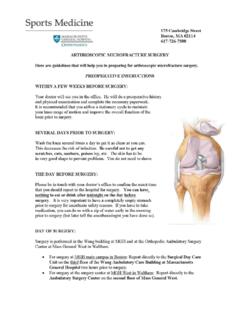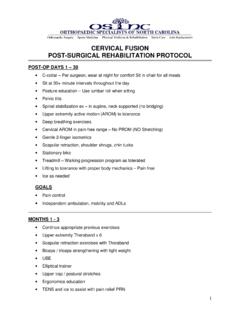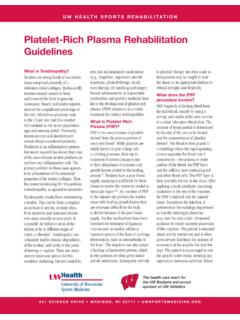Transcription of Writing a Letter of Medical Necessity for a Wheelchair
1 Writing a Letter of Medical Necessity for a Wheelchair Susan Christie, PT, ATP June 2015 2 Objectives Identify 5 components of a Letter of Medical Necessity Explain the Medicare algorithm for MAE (Mobility-assistive Equipment) Give 3 examples of MRADLs (Mobility-related Activities of Daily Living 3 Purpose of the LMN Documents the Medical need for the recommended equipment Allows the payer to understand the needs and authorize the equipment Provides specs for the Wheelchair checkout at delivery 4 Persons involved Client Caregivers Therapist Supplier (ATP) Physician (sometimes on-site) 5 Client Gives an accurate history Indicates his/her needs and desires Participates in discussion of components and strategies 6 Therapist Performs a comprehensive evaluation Documents the evaluation and Wheelchair specs Justifies each component of the chair Follows up as needed 7 Supplier Checks same or similar equipment Provides order forms and information Participates in the selection of the equipment Educates the physician about MC rules Obtains physician signatures 8 The Evaluation includes.)
2 Detailed history Neuromuscular status Sensation Pain Functional status 9 The Evaluation Social/living situation Mobility needs and recommendations Seating and positioning needs and recommendations 10 Mobility limitation or deficit Something that prevents the consumer from accomplishing his/her MRADLs at all, or places them at a heightened risk of morbidity or mortality because of the attempts to perform an MRADL , or to accomplish it in a reasonable time frame MRADLs (as per Medicare) Toileting Dressing Grooming Bathing Feeding 12 Medicare algorithm Cane or walker? Y/N Standard Wheelchair ? Y/N Light weight Wheelchair ? Y/N High strength light weight Wheelchair ? Y/N 13 Medicare algorithm Optimally-configured manual Wheelchair ? Y/N Scooter? Y/N Power Wheelchair ? Y/N Ruling out manual Wheelchair Trial with optimally-configured chair Objective data about consumer s performance: time/distance, heart rate, pulse ox, blood pressure, perceived exertion 14 Ruling out manual Wheelchair Environment.
3 Smooth surfaces, carpet, rugs, door sills, ramps Availability of caregiver to push chair 15 16 Ruling out scooter Safe transfer on and off Ability to sit on fish-on seat Use of both upper extremities Sufficient use of thumbs/fingers Sufficient room within the home 17 Another criteria The person has not expressed an unwillingness to use the recommended device Type of language Use the most precise terms but assume that the reader has limited knowledge Use the language written in the policy State the policy number and quote from it (cut and paste) 18 19 In the home Medicare is saying that without this equipment, the user would not be able to get to the bathroom, bedroom, meals, etc Any item that is used only for mobility outside the home is not covered 20 In the Home Getting to the bathroom for toileting, bathing, and grooming Getting to an area for dressing Getting to the bedroom for sleeping Getting to meals 21 Functions not included Medical appointments such as doctor and therapy Social events Exercise Getting the mail Doing laundry 22 LMN for power Wheelchair Analyze section by section P.
4 T. Evaluation for Mobility-Assistive Device Provider name: Bryn Mawr Rehabilitation Hospital Medicare provider no. 393025 Patient name: Jill Brown Insurance company: Medicare Policy #: 1234M Referring physician: Lauren Wilson MD Start of care date: 4-15-15 Primary diagnosis: ALS Treating diagnosis: gait dysfunction GOALS Evaluate mobility and need for power Wheelchair Access to Mobility-related ADL s within the home ASSESSMENT Jill is a 57 year old woman who is unable to walk or to self-propel a manual Wheelchair .
5 And who requires a power Wheelchair in order to move around within her home to access her MRADLs TREATMENT PLAN Pursue documentation and funding for a power Wheelchair Follow up visit once new equipment arrives _____ The patient was involved in the goal-setting and is in agreement with the plan Frequency and duration of treatment: one visit, 4-15-15, 10:300am-12:15 pm _____ _____ Susan Christie PT, ATP DATE I have read this plan of treatment and these recommendations and agree with them _____ _____ Ling Chen MD DATE Medical history: ALS diagnosed in November 2014. Unable to speak, and is fed mostly by tube feedings. Dependent lower extremity edema.
6 She uses a BiPap at night and part-time during the day. She is 5 6 , 106 pounds, BMI , (underweight) Social: Jill lives alone in a one-story home with a ramp to enter, and has some assistance during the day. She is unable to speak and uses a text-to-speech program on her iPad to communicate face-to-face, and uses email for remote communication Neuromuscular status: quadriplegia. Trunk and neck strength are 2/5 with very weak cough. Upper extremities have functional passive range with shoulder strength grossly 3-/5, elbow 3+/5, grip 2/5 with wasting of the intrinsic muscles of the hands. Lower extremities show functional passive range of motion. Right hip flexion 1/5, knee extension 2-/5, ankle 1/5. Left hip flexion 2-/5, knee extension 3-/5, ankle 2+/5. She does not report any loss of sensation, but does report pins and needles in her right leg and left arm. She wears a neck brace to hold her head up because she does not have enough strength to lift it against gravity.
7 Pain: Jill reports pain from muscle cramping, all over her body especially in the large muscle of her legs which are not relieved by medication or changing position Functional ability: Jill transfers independently with a walker or sturdy grab bar for stability. She is independent in toileting, grooming, and feeding with set-up once she is at the appropriate location. Meals are prepared by friends or caregivers. She showers using a shower bench with assistance of one person. Jill demonstrated her ability to drive a power Wheelchair safely using a joystick, going forward, backward, making turns, and navigating through a 36 wide doorway. She was able to avoid people and obstacles in the halls and to get on and off an elevator. Jill has a mobility deficit which cannot be remediated with a cane or walker as she is unable to stand or walk due to ALS and insufficient muscle strength. She is unable to propel any type of Wheelchair because she does not have enough trunk, arm, or leg strength and she does not have a caregiver available 24/7 who can push her in a manual Wheelchair .
8 She is not able to operate a scooter (POV) because she does not have enough strength to use a tiller-type control, so she requires a power Wheelchair in order to move around within her home and to access her MRADLs. She needs to get to the bedroom for sleeping, the bathroom for toileting and bathing, and to the kitchen and eating area for her meals. Without a power Wheelchair , she would be unable to perform her MRADLs because she would not be able to get to the appropriate location within her home. Current mobility equipment: Revo three-wheeled scooter borrowed from a friend. Loaner power Wheelchair from the ALS Association to be delivered to her following this appointment as she is no longer able to use the scooter. Borrowed transport Wheelchair , shower bench, commode, and walker for transfers Josh Harris ATP of ABC DME Company was present at this evaluation and participated in the selection of the equipment. BMRH has no financial relationship with this DME company.
9 Jill had a chance to see several mid-wheel drive power wheelchairs as well as a Permobil front-wheel drive Wheelchair . She drove the front-wheel drive Permobil. Jill did not expressed an unwillingness to use the equipment that has been recommended RECOMMENDATIONS -Permobil C300 front wheel drive power Wheelchair , set up for multiple power seat functions, to give her safe and independent mobility and access to all areas of her home and her ADLs. This Wheelchair base can accept the power seating functions that she needs to manage her quadriplegia -Flat- free inserts in tires as she cannot fill air tires -Shroud color purple rain with matching hub caps -Power adjustable seat height to allow her to transfer more safely by raising the seat to assist her into the upright position for the stand-pivot transfer. -One pair of sealed gel batteries and charger to power the chair -Fixed vent shelf for BiPap so that she can have it with her at all times to assist in her breathing -Enhanced steering platform, required with vent shelf to assure that Jill will be able to drive the Wheelchair safely with the vent shelf on it -R-net remote joystick with mono-jacks, needed to drive the chair and access all of the power seat functions -Standard joystick knob -Retractable joystick hardware on right side so she can move the joystick out of the way for transfers -Expandable controller and wiring harness, needed for multiple power seat functions and appropriate for Jill and her neurological diagnosis -C3G power tilt and power recline.
10 Jill needs the power tilt so that she can shift her weight and reposition herself in the seat as she is unable to perform an effective weight shift due to her quadriplegia and the progressive nature of ALS. She needs the power recline to change her hip angle to accommodate for her trunk and neck weakness and her inability to hold herself upright against gravity, and for skin pressure management as she is unable to perform an effective weight shift. The combination of the two power seat functions is more effective for her than either one alone -Multiple power seat function control kit to allow use of more than two power seat functions through the joystick, needed by Jill because of her quadriplegia -Push buttons on ICS box, mount onto R-net joystick bracket -Solid back, 16 W X 25 H to support her partially-paralyzed trunk -Roho back cushion with adjustable air to cushion her back and protect her skin. She is very boney and is at risk of pressure ulcers along her spine as she leans heavily on the back for support -One pair of foam wedges (Quantum) to further contour the back for postural stability -Narrow corpus seat frame, 17 W X 19 D for body measurements of hip width 16 and seat depth 19 -Roho seat cushion, full profile, single valve for adjustable skin protection.
